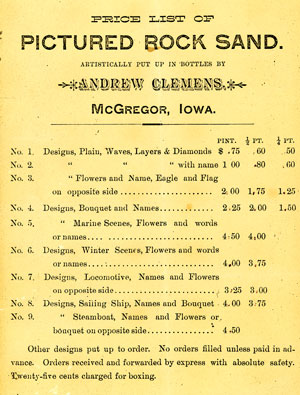March-April 2011
Highlights and Links
Follow the links for more information
about
Upper Mississippi stories and news in this
issue of Big River.
River news from this issue
Features:
|
A Mink's Year
by Kenny Salwey
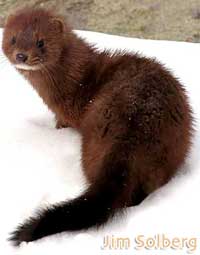 River man and popular author Kenny Salwey takes us through a mink's year on the river. River man and popular author Kenny Salwey takes us through a mink's year on the river.
|
Sand Bottles of Andrew Clemens
by Trudy Balcom
Andrew Clemens of McGregor, Iowa, created intricate artwork out of sand in bottles. Read about his life and work in this issue of Big River.

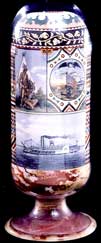 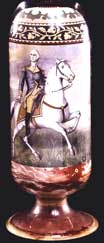 |
  |
The George Washington bottle is regarded as Clemen's masterpiece. It was completed by 1888, and was a gift to his mother. It is now in the collection of the State Historical Society Museum in Des Moines. (Photo courtesy of the McGregor Public Library) |
This enchanting little bottle is typical of the bottles customers commissioned as gifts. The rowboat scene looks like one that would have been typical on the Mississippi River during Clemens time. (Photo courtesy private collector) |
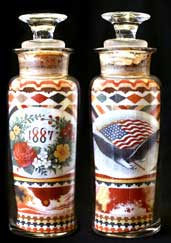
This 1887 Floral and flag bottle shows the delicacy Clemens was able to bring to the most common themes with the maturity of his skill. This bottle was completed when he was 30 years old. (Photo courtesy private collector) |
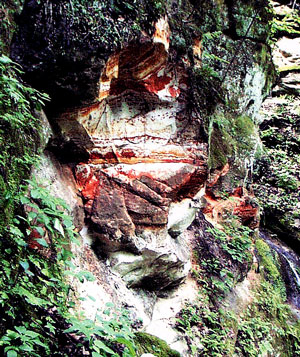 |
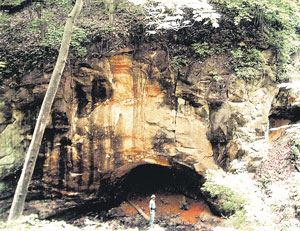
|
Above: This outcrop, near Pictured Rocks, is about 20 inches wide. The St. Peter Sandstone formation, which occurs across much of the Upper Midwest, is thickest at Pikes Peak State Park, varying from 90 to 223 feet thick. (Photo from McGregor Historical Museum, also in "The Natural History of PIkes Peak State Park, Clayton County Iowa," Nov. 2000, Geological Society of Iowa.)
Left: Pictured Rocks Cave. Long known simply as Pictured Rocks, the cave,located today in Pike's Peak State Park, was where Andrew Clemens collected much of the sand used in his artwork. Locals say there are 42 different colors of sand in the cave. (Photo courtesy of the McGregor Historical Museum) |
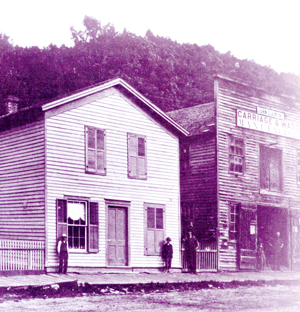
The Clemens family lived in the building seen to the left of their wagon shop on Main Street in McGregor, Iowa. Probably some of the six Clemens sons and Mr. Clemens appear in the photo, but they are not identified. Andrew's workbench was said to have been located behind the window with the decorative shade, so people could look in and watch him at work. (Photo courtesy of the McGregor Historical Museum) |
|
|
Mississippian Dig in Trempealeau, Wis.
By Ernie Bozhardt
For the last two summers a team of archaeologists have been unearthing clues about people who paddled dugout canoes nearly a thousand years ago 500 miles up the Mississippi River from Cahokia to settle where Stoddard and Trempealeau, Wis., are today.
These people, who we call “Mississippians,” ventured into territory occupied by the people who built animal-shaped effigy mounds. What was the purpose of this great undertaking? Did it succeed or fail?
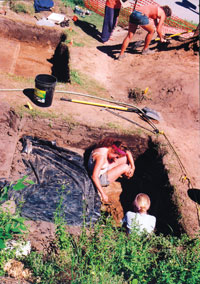 |
Visit The Mississippian Initiative on Facebook
 |
Students dig for clues to the Mississippian culture in Trempealeau, Wis. (Reggie McLeod) |
Two students clear a mound from a cleared ramp leading to Mound 3. View is to the north. (Ernie Boszhardt) |
Summer River Adventures Wrap-up
We bring you the fate of three very different groups of adventurers who tackled the Mississippi this last summer. Read about the Unseen Ghost Brigade, the two friends from Norway in an oarboat and two paddlers Canoeing for the Cure.
Eddy Ferreira and Jan Bronnich and their photo pages
 Unseen Ghost Brigade and their Facebook page Unseen Ghost Brigade and their Facebook page
Aaron Drendel and Jake Mullins
Big River's River trips page.
 |
The End of Winter on the River
By Jeff Lessard |
| |
Read about Jeff's river adventures
on those last cold days of winter. |
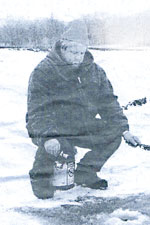

|
"I travel a little farther upriver to the dam at Lynxville, crowded with fishermen trying to catch walleyes. I’ve walked the ice here to fish, inching closer to open water and with each step thinking my foot would break through, because the ice was so clear it was like walking on glass…"

"He was the kind of man who, if you told him to catch a fish, would ask what kind, then go out to a mud puddle in the street and bring one back and tell you he could have caught more but he quit because the truck traffic was so bad."
"I told him my dilemma, and not looking up, he said carp are one of the smartest fish on the river, and they can feel you breathe. That’s what those feelers are for. The next time I saw that familiar nose poke out, I not only drew my bow and held it, but I drew my breath and held it."
|
|


 Unseen Ghost Brigade and their Facebook page
Unseen Ghost Brigade and their Facebook page 
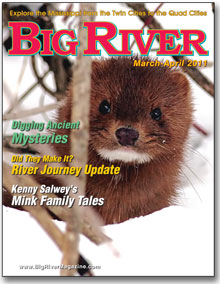






 River man and popular author Kenny Salwey takes us through a mink's year on the river.
River man and popular author Kenny Salwey takes us through a mink's year on the river.







